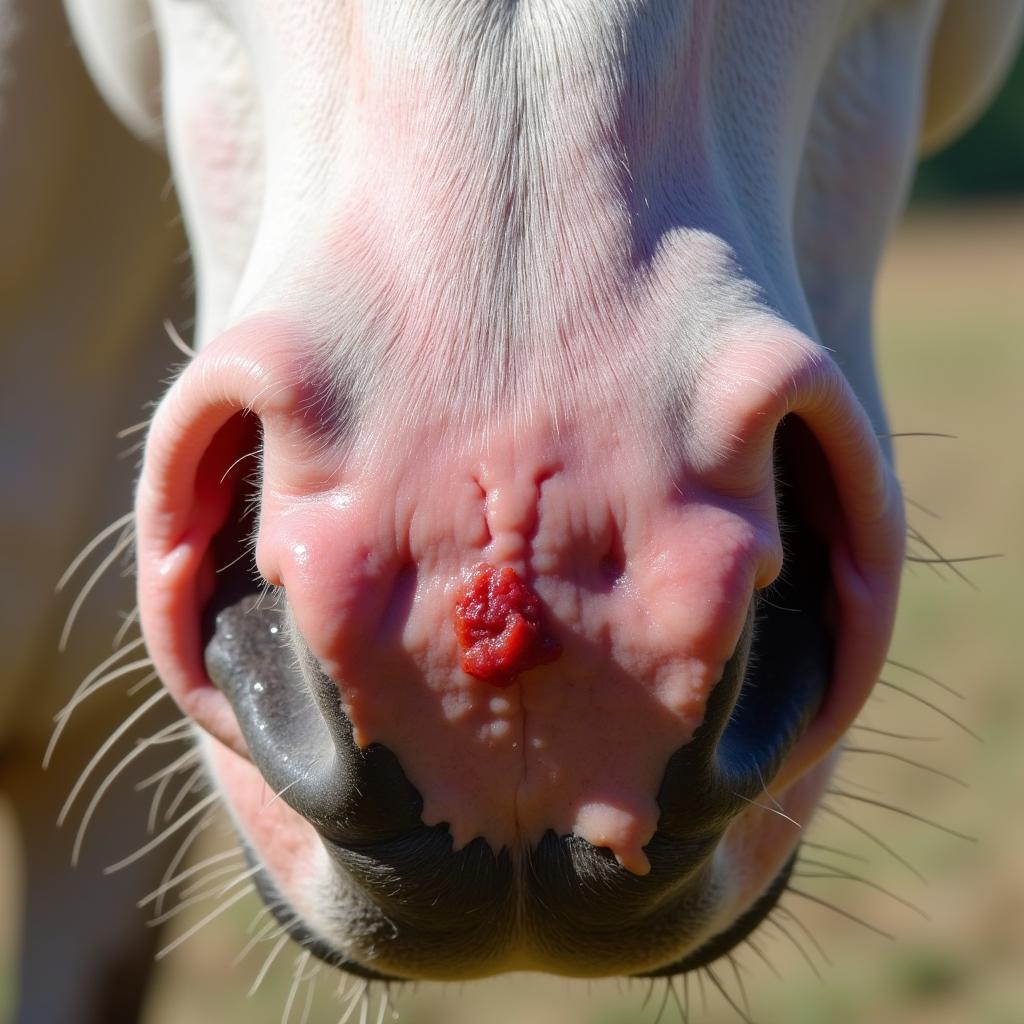Equine skin cancer can be a serious concern for horse owners. Understanding how to identify potential signs through Horse Skin Cancer Pictures and seeking veterinary advice are crucial steps in managing the disease effectively. This article provides valuable insights into different types of equine skin cancer, their visual characteristics, and essential care recommendations.
Equine skin cancers manifest in various forms, each with its unique appearance and implications. Squamous cell carcinoma, melanoma, and sarcoids are among the most common types. Recognizing these through horse skin cancer pictures can be a helpful first step in early detection. Let’s delve into the details of these cancers.
Understanding Equine Skin Cancers
Squamous cell carcinoma often appears as raised, ulcerated sores, especially in areas with less pigment, such as around the eyes, genitals, and muzzle. Melanomas, frequently seen in gray horses, can present as darkly pigmented lumps or nodules, often in the perineal region, under the tail, and around the mouth. Sarcoids, while technically benign tumors, can resemble warts or fleshy growths and may occur anywhere on the body.
Accurate diagnosis requires a veterinary examination, often involving a biopsy. Early detection and intervention greatly improve the prognosis. Regularly examining your horse’s skin and consulting a veterinarian if you notice any suspicious growths or lesions is vital for prompt management.
Sarcoids are the most common skin tumors in horses. For more information and visual aids, you can explore our resource on sarcoids in horses pictures.
 Equine Squamous Cell Carcinoma Example
Equine Squamous Cell Carcinoma Example
What to Look For: Identifying Skin Cancer in Horses
Changes in your horse’s skin, such as new growths, sores that don’t heal, or alterations in existing moles or warts, should be investigated. While horse skin cancer pictures can be a useful starting point, they should not replace professional veterinary diagnosis.
Here are some key things to look out for:
- Unusual growths: Any new lump, bump, or mass that appears on your horse’s skin warrants attention.
- Non-healing sores: Sores that don’t heal within a reasonable timeframe could be indicative of an underlying issue.
- Changes in existing markings: Pay close attention to any changes in the size, shape, or color of existing moles, warts, or other skin markings.
- Hair loss: Localized hair loss, especially in conjunction with other skin changes, should be investigated.
- Bleeding or discharge: Any bleeding or discharge from a skin lesion requires veterinary attention.
 Melanoma in a Gray Horse Example
Melanoma in a Gray Horse Example
Caring for a Horse with Skin Cancer
Treatment options for equine skin cancer vary depending on the type, location, and stage of the cancer. Surgery, cryotherapy, radiation therapy, and immunotherapy are some of the potential approaches. Your veterinarian will recommend the most appropriate course of action based on your horse’s individual circumstances.
Melanoma can sometimes spread internally in horses. For more information on this, please visit signs of internal melanoma in horses.
Supportive care plays a vital role in managing a horse with skin cancer. This may include pain management, wound care, and nutritional support. Working closely with your veterinarian to develop a comprehensive care plan is crucial for ensuring your horse’s comfort and well-being.
Conclusion: Early Detection is Key in Equine Skin Cancer
Horse skin cancer pictures can be valuable tools in raising awareness and aiding in the early identification of potential skin cancer in horses. However, a definitive diagnosis requires professional veterinary assessment. Regular skin checks, prompt veterinary consultation for any suspicious changes, and adherence to recommended treatment plans are essential for managing equine skin cancer effectively.
FAQ: Horse Skin Cancer
- What is the most common type of skin cancer in horses? Sarcoids.
- Are all equine skin tumors cancerous? No, some, like sarcoids, are benign.
- Can skin cancer in horses be cured? The prognosis varies depending on the type and stage.
- What are the signs of melanoma in horses? Darkly pigmented lumps or nodules.
- How is equine skin cancer diagnosed? Through a veterinary examination, often including a biopsy.
- What are the treatment options for equine skin cancer? Surgery, cryotherapy, radiation therapy, and immunotherapy.
- How can I prevent skin cancer in my horse? Regular skin checks and minimizing sun exposure for susceptible horses.
Curious about the costs associated with horse ownership? Check out white horse village cost.
For further assistance, please contact us: Phone: 0772127271, Email: [email protected] or visit us at QGM2+WX2, Vị Trung, Vị Thuỷ, Hậu Giang, Việt Nam. Our customer service team is available 24/7.